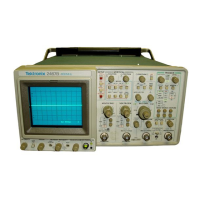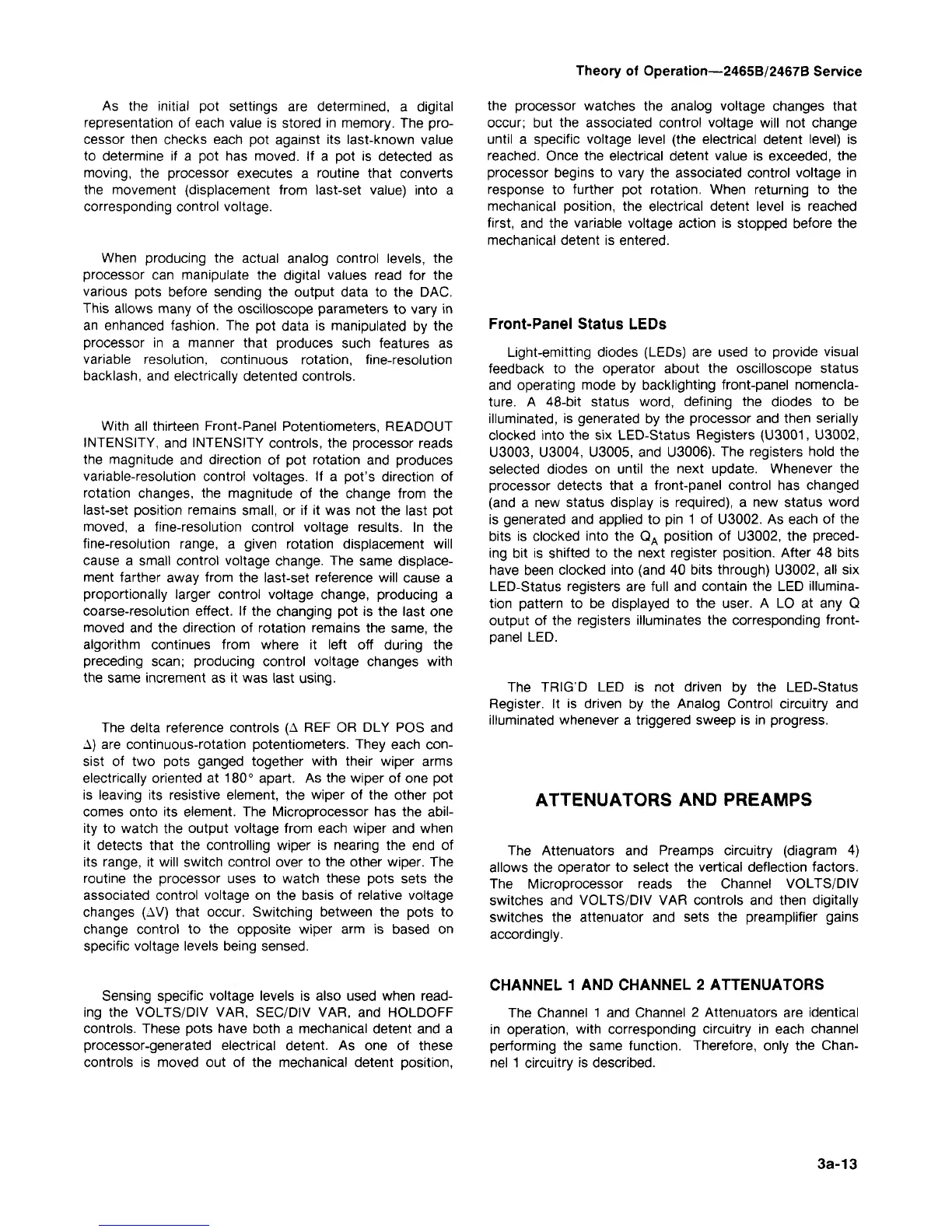Theory of Operation—2465B/2467B Service
As the initial pot settings are determined, a digital
representation of each value is stored in memory. The pro-
cessor then checks each pot against its last-known value
to determine if a pot has moved. If a pot is detected as
moving,
the processor executes a routine that converts
the movement (displacement from last-set value) into a
corresponding control voltage.
When producing the actual analog control levels, the
processor can manipulate the digital values read for the
various pots before sending the output data to the DAC.
This allows many of the oscilloscope parameters to vary in
an enhanced fashion. The pot data is manipulated by the
processor in a manner that produces such features as
variable resolution, continuous rotation, fine-resolution
backlash,
and electrically detented controls.
With all thirteen Front-Panel Potentiometers, READOUT
INTENSITY, and INTENSITY controls, the processor reads
the magnitude and direction of pot rotation and produces
variable-resolution control voltages. If a pot's direction of
rotation changes, the magnitude of the change from the
last-set position remains small, or if it was not the last pot
moved,
a fine-resolution control voltage results. In the
fine-resolution range, a given rotation displacement will
cause a small control voltage change. The same displace-
ment farther away from the last-set reference will cause a
proportionally larger control voltage change, producing a
coarse-resolution effect. If the changing pot is the last one
moved and the direction of rotation remains the same, the
algorithm continues from where it left off during the
preceding scan; producing control voltage changes with
the same increment as it was last using.
The delta reference controls (A REF OR DLY POS and
A) are continuous-rotation potentiometers. They each
con-
sist of two pots ganged together with their wiper arms
electrically oriented at 180° apart. As the wiper of one pot
is leaving its resistive element, the wiper of the other pot
comes onto its element. The Microprocessor has the
abil-
ity to watch the output voltage from each wiper and when
it detects that the controlling wiper is nearing the end of
its range, it will switch control over to the other wiper. The
routine the processor uses to watch these pots sets the
associated control voltage on the basis of relative voltage
changes (AV) that occur. Switching between the pots to
change control to the opposite wiper arm is based on
specific voltage levels being sensed.
Sensing specific voltage levels is also used when
read-
ing the VOLTS/DIV VAR, SEC/DIV VAR, and HOLDOFF
controls. These pots have both a mechanical detent and a
processor-generated electrical detent. As one of these
controls is moved out of the mechanical detent position,
the processor watches the analog voltage changes that
occur; but the associated control voltage will not change
until a specific voltage level (the electrical detent level) is
reached.
Once the electrical detent value is exceeded, the
processor begins to vary the associated control voltage in
response to further pot rotation. When returning to the
mechanical position, the electrical detent level is reached
first, and the variable voltage action is stopped before the
mechanical detent is entered.
Front-Panel Status LEDs
Light-emitting diodes (LEDs) are used to provide visual
feedback to the operator about the oscilloscope status
and operating mode by backlighting front-panel nomencla-
ture.
A 48-bit status word, defining the diodes to be
illuminated,
is generated by the processor and then serially
clocked into the six LED-Status Registers
(U3001,
U3002,
U3003,
U3004, U3005, and U3006). The registers hold the
selected diodes on until the next update. Whenever the
processor detects that a front-panel control has changed
(and a new status display is required), a new status word
is generated and applied to pin 1 of U3002. As each of the
bits is clocked into the Q
A
position of U3002, the preced-
ing bit is shifted to the next register position. After 48 bits
have been clocked into (and 40 bits through) U3002, all six
LED-Status registers are full and contain the LED illumina-
tion pattern to be displayed to the user. A LO at any Q
output of the registers illuminates the corresponding front-
panel LED.
The TRIG'D LED is not driven by the LED-Status
Register. It is driven by the Analog Control circuitry and
illuminated whenever a triggered sweep is in progress.
ATTENUATORS AND PREAMPS
The Attenuators and Preamps circuitry (diagram 4)
allows the operator to select the vertical deflection factors.
The Microprocessor reads the Channel VOLTS/DIV
switches and VOLTS/DIV VAR controls and then digitally
switches the attenuator and sets the preamplifier gains
accordingly.
CHANNEL
1
AND CHANNEL
2
ATTENUATORS
The Channel 1 and Channel 2 Attenuators are identical
in operation, with corresponding circuitry in each channel
performing the same function. Therefore, only the Chan-
nel 1 circuitry is described.
3a-13

